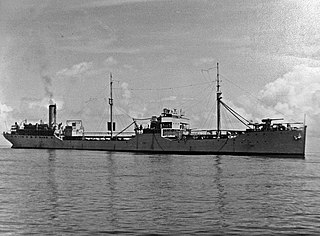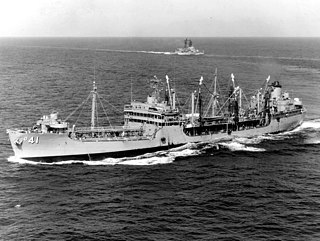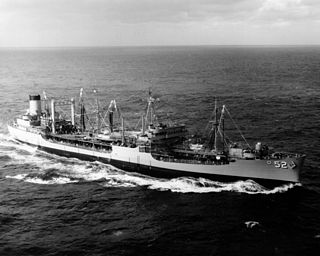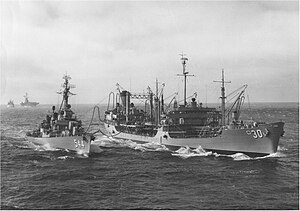
USS Patoka (AO–9/AV–6/AG–125) was a replenishment oiler made famous as a tender for the airships Shenandoah (ZR-1), Los Angeles (ZR-3) and Akron (ZRS-4). It was also notable in that its height figured prominently in the design of the Rainbow Bridge in Texas.

USS Guadalupe (AO-32), a Cimarron-class fleet replenishment oiler that served in the United States Navy, it was named for the Guadalupe River in Texas.

USS Kaweah (AO-15) was the lead ship of her class of fleet replenishment oilers in the United States Navy.

USS Laramie (AO-16) was a Kaweah-class fleet replenishment oiler in the United States Navy.

USS Mattole (AO‑17) was a Kaweah-class fleet replenishment oiler in the United States Navy.

USS Rapidan (AO-18), was a US Navy tanker of World War II.

USS Cimarron (AO-22) was a Cimarron-class oiler serving with the United States Navy and the second ship to be named for the Cimarron River in the Southwestern United States. She was launched 7 January 1939 by Sun Shipbuilding and Drydock Company, Chester, Pennsylvania; sponsored by Mrs. William D. Leahy; and commissioned 20 March 1939 with Lieutenant Commander William W. Behrens, Sr. in command.

The third USS Merrimack (AO-37) (ex-Caddo) was one of five Kennebec-class fleet oilers built during World War II for service in the United States Navy. She also service in the Cold War. She was named after the Merrimack River in Massachusetts and New Hampshire.

USS Platte (AO-24) was a Cimarron-class oiler serving with the United States Navy, named for the 1836 Platte Purchase that included the Platte Rivers in Iowa, Missouri and Nebraska. Her memorial in Platte County, Missouri honors all four rivers that share the name recorded by Lewis and Clark in 1803.

USS Conecuh (AOR-110) was a fleet replenishment tanker, originally built by F. Schichau, Danzig, in 1938 as a combination oiler and supply vessel or "Troßschiff" for the Kriegsmarine and christened as Dithmarschen. Taken over by British authorities at Bremerhaven when World War II ended, Dithmarschen was allocated to the United States Navy on 15 January 1946 by the Inter-Allied Reparations Commission.

USS Neosho (AO–48) was a Kennebec-class type T2 fleet oiler of the United States Navy. The ship was laid down on 8 July 1941, as SS Catawba, by the Bethlehem-Sparrows Point Shipyard Inc., Sparrows Point, Maryland. The purchase came under Maritime Commission contract number 145 for the Socony-Vacuum Oil Company, later renamed Mobil Oil.

USS Kankakee (AO-39) was a Kennebec-class fleet oiler of the United States Navy. The ship was built as SS Colina by Bethlehem Steel Co., Sparrows Point, Maryland, launched on 24 January 1942, sponsored by Mrs. D. A. Little, acquired for the Navy on 31 March through the Maritime Commission from her owner, Socony-Vacuum Oil Company, New York City, and commissioned as Kankakee at Norfolk, Virginia, on 4 May.

USS Mattaponi (AO-41) was a Kennebec-class oiler which served in the United States Navy during World War II, periodically during the 1950s, and in the Vietnam War. She was the only U.S. Navy ship named for the Mattaponi River in eastern Virginia.

The USS Manatee (AO-58)—the second vessel of the United States Navy to bear the name—was a Cimarron-class fleet replenishment oiler named for a river in Florida. Cimarron-class oilers were named after American rivers in the southern United States.

USS Niobrara (AO-72) was a T3 Kennebec-class oiler constructed for the United States Navy during World War II. She was the only U.S. Navy ship named for the Niobrara River in Nebraska.

USS Elokomin (AO-55) was a Cimarron-class fleet oiler acquired by the U.S. Navy during World War II. She served her country primarily in the Atlantic Ocean, Mediterranean Sea, and the North Atlantic Ocean Theatre of Operations, and provided petroleum products where needed to combat ships.

USS Cacapon (AO-52) was a T3 Cimarron-class fleet oiler acquired by the U.S. Navy during World War II. She served her country primarily in the Pacific Ocean Theater of Operations, and provided petroleum products where needed to combat ships. For performing this dangerous task, she was awarded battle stars and citations during World War II, the Korean War, and the Vietnam War.

USS Housatonic (AO-35) was a Chicopee-class oiler acquired by the United States Navy for use during World War II. She was the third ship of the U.S. Navy named for the Housatonic River in Massachusetts and Connecticut.

USS Chiwawa (AO-68) is a former T3-S-A1 Kennebec-class oiler constructed for the United States Navy during World War II. She was the only U.S. Navy ship named for the Chiwawa River in Washington.

USS Chukawan (AO-100) was a Cimarron-class fleet oiler constructed for the U.S. Navy in the closing days of World War II.




















